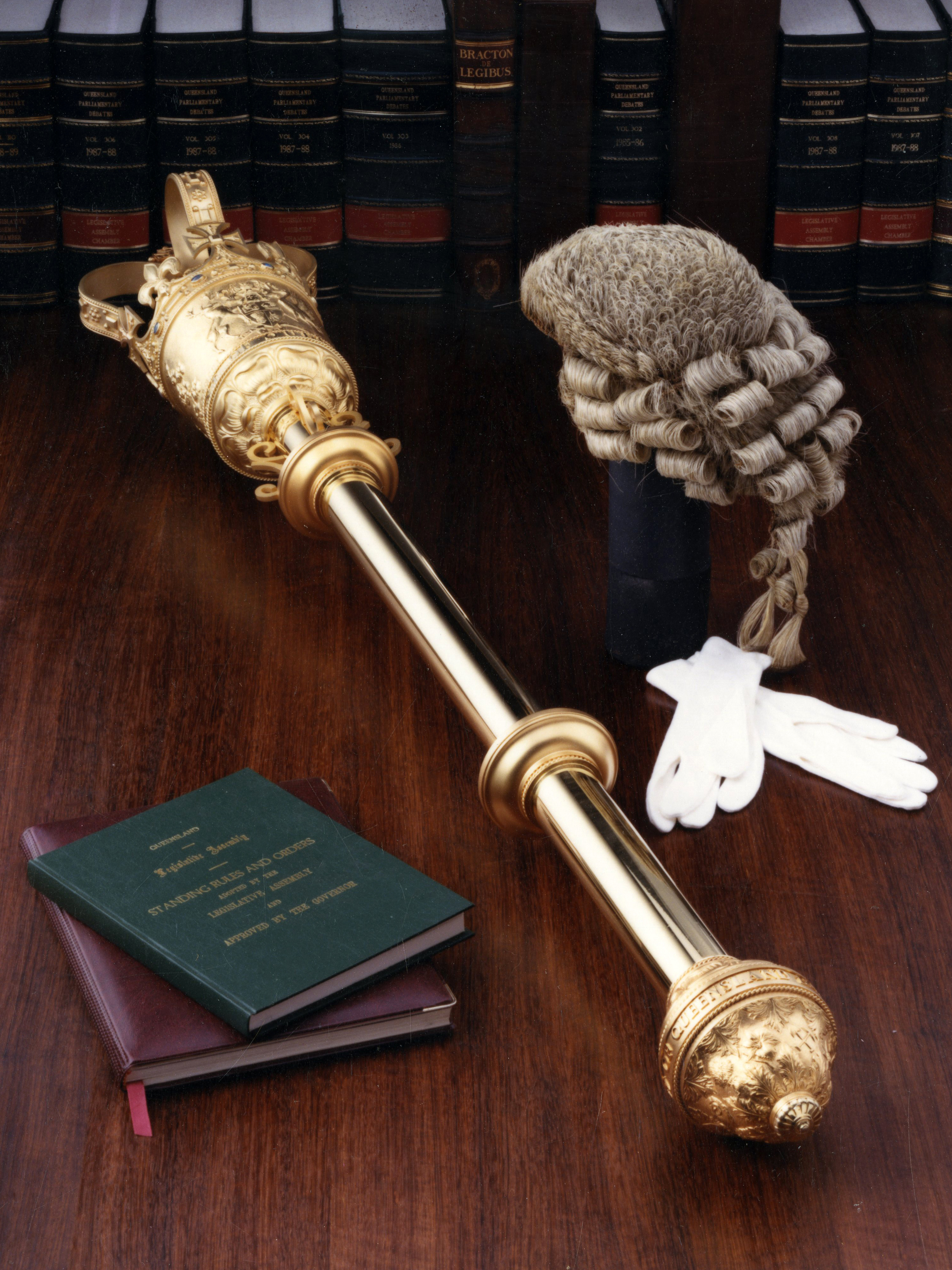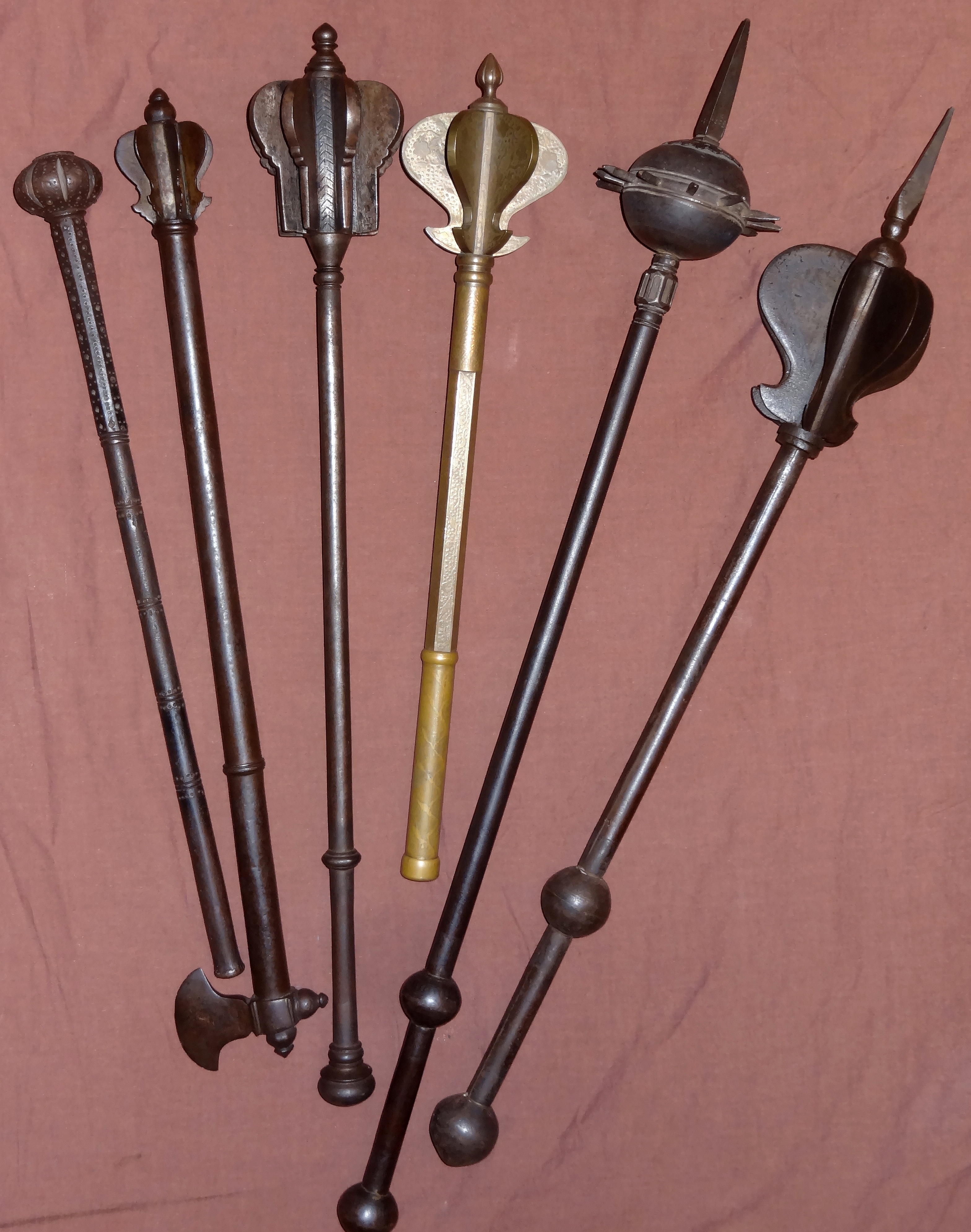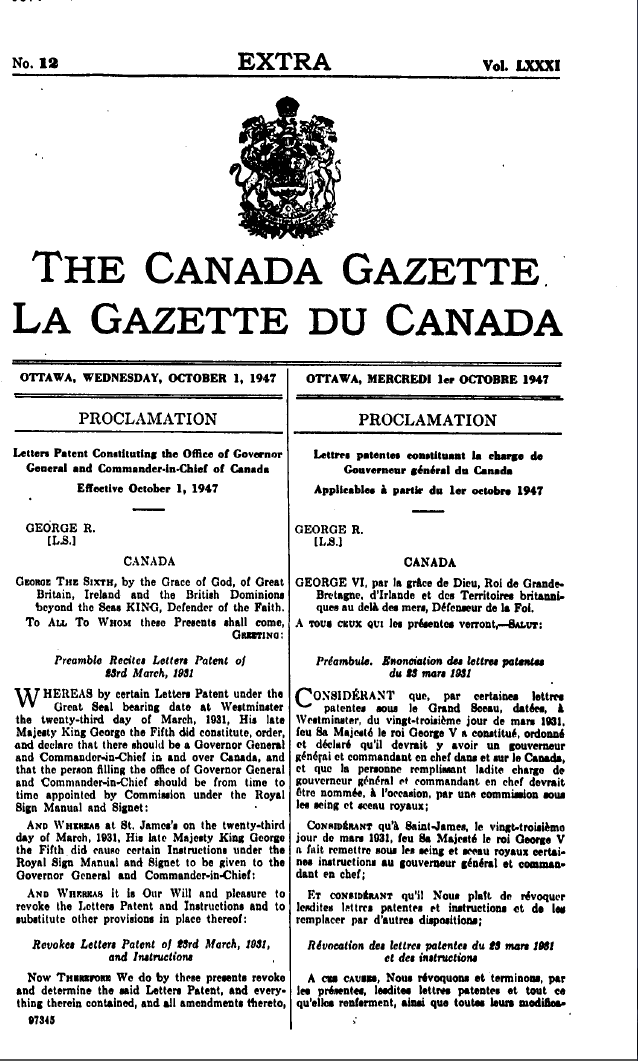|
Sergeant-at-arms
A serjeant-at-arms, or sergeant-at-arms, is an officer appointed by a deliberative body, usually a legislature, to keep order during its meetings. The word "serjeant" is derived from the Latin ''serviens'', which means "servant". Historically, serjeants-at-arms were armed men retained by English lords and monarchs, and the ceremonial maces which they are associated with were originally a type of weapon. Origins The term "sergeant" can be given two main definitions; the first being a military rank and the other a governmental role. Whereas technically the two roles were not mutually exclusive, they were very different in roles and duties. The soldier sergeant was a man of what would now be thought of as the 'middle class', fulfilling a junior role to the knight in the medieval hierarchy. Sergeants could fight either as heavy to light cavalry, or as well-trained professional infantry, either spearmen or crossbowmen. Most notable medieval mercenaries fell into the 'sergeant' class ... [...More Info...] [...Related Items...] OR: [Wikipedia] [Google] [Baidu] |
2014 Shootings At Parliament Hill, Ottawa
The 2014 shootings at Parliament Hill were a series of shootings that occurred on October 22, 2014, at Parliament Hill in Ottawa. At the Canadian National War Memorial, Corporal Nathan Cirillo, a Canadian soldier and reservist on ceremonial sentry duty, was fatally shot by Islamic terrorist Michael Zehaf-Bibeau. Zehaf-Bibeau then entered the nearby Centre Block parliament building, where members of the Parliament of Canada were attending caucuses. After wrestling with a constable at the entrance, Zehaf-Bibeau ran inside and had a shootout with RCMP officers. He was shot 31 times by six officers and died on scene.parl.gc.ca: "October 22, 2014 House of Commons Incident Response Summary" , 3 Jun 2015 Following the shootings, the [...More Info...] [...Related Items...] OR: [Wikipedia] [Google] [Baidu] |
Ceremonial Mace
A ceremonial mace is a highly ornamented staff of metal or wood, carried before a sovereign or other high officials in civic ceremonies by a mace-bearer, intended to represent the official's authority. The mace, as used today, derives from the original mace used as a weapon. Processions often feature maces, as on parliamentary or formal academic occasions. History Ancient Near East Ceremonial maces originated in the Ancient Near East, where they were used as symbols of rank and authority across the region during the late Stone Age, Bronze Age, and early Iron Age. Among the oldest known ceremonial maceheads are the Ancient Egyptian Scorpion Macehead and Narmer Macehead; both are elaborately engraved with royal scenes, although their precise role and symbolism are obscure. In later Mesopotamian art, the mace is more clearly associated with authority; by the Old Babylonian period the most common figure on cylinder seals (a type of seal used to authenticate clay documents) ... [...More Info...] [...Related Items...] OR: [Wikipedia] [Google] [Baidu] |
René Jalbert
René Marc Jalbert (20 February 1921 – 21 January 1996) was a retired Canadian Forces officer and sergeant-at-arms of the National Assembly of Quebec, known for his role in ending Denis Lortie's killing spree in the Parliament Building on 8 May 1984. Later he served as Usher of the Black Rod for the Parliament of Canada. Military career Jalbert served in World War II and the Korean War, ultimately attaining the rank of major in the Royal 22e Régiment. Sergeant-at-arms After his military career, he served as sergeant-at-arms in the National Assembly of Quebec. On 8 May 1984, Denis Lortie entered the Parliament Building in the morning, before government business had begun, killing three government employees and wounding 13 others on his way to the Assembly Chamber. Upon learning of Lortie's presence, Jalbert entered the Assembly Chamber. Seeing Lortie in uniform, Jalbert showed the gunman his identification as a military veteran, opening a dialogue with him. Jalbert c ... [...More Info...] [...Related Items...] OR: [Wikipedia] [Google] [Baidu] |
House Of Commons Of Canada
The House of Commons of Canada (french: Chambre des communes du Canada) is the lower house of the Parliament of Canada. Together with the Crown and the Senate of Canada, they comprise the bicameral legislature of Canada. The House of Commons is a democratically elected body whose members are known as members of Parliament (MPs). There have been 338 MPs since the most recent electoral district redistribution for the 2015 federal election, which saw the addition of 30 seats. Members are elected by simple plurality ("first-past-the-post" system) in each of the country's electoral districts, which are colloquially known as ''ridings''. MPs may hold office until Parliament is dissolved and serve for constitutionally limited terms of up to five years after an election. Historically, however, terms have ended before their expiry and the sitting government has typically dissolved parliament within four years of an election according to a long-standing convention. In any case, an ac ... [...More Info...] [...Related Items...] OR: [Wikipedia] [Google] [Baidu] |
Ceremonial Mace
A ceremonial mace is a highly ornamented staff of metal or wood, carried before a sovereign or other high officials in civic ceremonies by a mace-bearer, intended to represent the official's authority. The mace, as used today, derives from the original mace used as a weapon. Processions often feature maces, as on parliamentary or formal academic occasions. History Ancient Near East Ceremonial maces originated in the Ancient Near East, where they were used as symbols of rank and authority across the region during the late Stone Age, Bronze Age, and early Iron Age. Among the oldest known ceremonial maceheads are the Ancient Egyptian Scorpion Macehead and Narmer Macehead; both are elaborately engraved with royal scenes, although their precise role and symbolism are obscure. In later Mesopotamian art, the mace is more clearly associated with authority; by the Old Babylonian period the most common figure on cylinder seals (a type of seal used to authenticate clay documents) ... [...More Info...] [...Related Items...] OR: [Wikipedia] [Google] [Baidu] |
Mace (bludgeon)
A mace is a blunt weapon, a type of club or virge that uses a heavy head on the end of a handle to deliver powerful strikes. A mace typically consists of a strong, heavy, wooden or metal shaft, often reinforced with metal, featuring a head made of stone, bone, copper, bronze, iron, or steel. The head of a military mace can be shaped with flanges or knobs to allow greater penetration of plate armour. The length of maces can vary considerably. The maces of foot soldiers were usually quite short (two or three feet, or sixty to ninety centimetres). The maces of cavalrymen were longer and thus better suited for blows delivered from horseback. Two-handed maces could be even larger. Maces are rarely used today for actual combat, but many government bodies (for instance, the British House of Commons and the U.S. Congress), universities and other institutions have ceremonial maces and continue to display them as symbols of authority. They are often paraded in academic, parliamentar ... [...More Info...] [...Related Items...] OR: [Wikipedia] [Google] [Baidu] |
Denis Lortie
Denis Lortie (born March 10, 1959) is a former Canadian Forces corporal. In 1984, he stormed into the Parliament Building in Quebec City and opened fire with several firearms, killing three government employees and wounding 13 others. The National Assembly's serjeant-at-arms, René Jalbert, volunteered himself to serve as a hostage, and conversed with Lortie for several hours before convincing him to surrender to authorities. After a 1985 conviction of first-degree murder was overturned by the Quebec Court of Appeal, Lortie pleaded guilty to reduced charges of second-degree murder in 1987, for which he was convicted and sentenced to life imprisonment with no parole for ten years. Lortie was granted day parole in 1995, then full parole in 1996, and has since kept a low profile among the general public. Life Denis Lortie was born in Quebec on March 10, 1959, as the youngest son of eight children. His exact birthplace within Quebec is not publicly known. Lortie and all his sibl ... [...More Info...] [...Related Items...] OR: [Wikipedia] [Google] [Baidu] |
Mace UK
Mace may refer to: Spices * Mace (spice), a spice derived from the aril of nutmeg * '' Achillea ageratum'', known as English mace, a flowering plant once used as a herb Weapons * Mace (bludgeon), a weapon with a heavy head on a solid shaft used to bludgeon opponents ** Flail (weapon), a spiked weapon on a chain, sometimes called a chain mace or mace-and-chain ** Ceremonial mace, an ornamented mace used in civic ceremonies ** Gada (mace), the blunt mace or club from India *** Kaumodaki, the gada (mace) of the Hindu God Vishnu * Mace (spray), a brand of tear gas, often used by police * MGM-13 Mace, a U.S. tactical surface-to-surface missile Science and technology * Major adverse cardiovascular events, a criterion for evaluating cardiovascular disease treatments such as angioplasty * Malone antegrade continence enema, a surgical procedure used to create a continent pathway proximal to the anus * Major Atmospheric Cerenkov Experiment Telescope, a telescope being built by ECIL to be ... [...More Info...] [...Related Items...] OR: [Wikipedia] [Google] [Baidu] |
British House Of Commons
The House of Commons is the lower house of the Parliament of the United Kingdom. Like the upper house, the House of Lords, it meets in the Palace of Westminster in London, England. The House of Commons is an elected body consisting of 650 members known as members of Parliament (MPs). MPs are elected to represent constituencies by the first-past-the-post system and hold their seats until Parliament is dissolved. The House of Commons of England started to evolve in the 13th and 14th centuries. In 1707 it became the House of Commons of Great Britain after the political union with Scotland, and from 1800 it also became the House of Commons for Ireland after the political union of Great Britain and Ireland. In 1922, the body became the House of Commons of the United Kingdom of Great Britain and Northern Ireland after the independence of the Irish Free State. Under the Parliament Acts 1911 and 1949, the Lords' power to reject legislation was reduced to a delaying power. T ... [...More Info...] [...Related Items...] OR: [Wikipedia] [Google] [Baidu] |
Parliament Building (Quebec)
The Parliament Building of Quebec (french: Hôtel du Parlement du Québec, links=no) is an eight-floor structure and is home to the National Assembly of Quebec (french: Assemblée Nationale du Québec, links=no), located in Quebec City, Quebec, Canada. The Parliament Building was designed by architect Eugène-Étienne Taché in a Second Empire style and built between 1877 and 1886, in the heart of Quebec's Parliament Hill. The National Assembly (or, as it was called until 1968, the Legislative Assembly) first met there on March 27, 1884, even as the building was fully completed only two years later, on April 8, 1886. In 1910s-1930s, the government has built several adjacent buildings to expand its office spaces, creating a parliamentary complex, of which the Parliament Building is the main edifice. The government office, is a successor of several earlier buildings, the earliest of which was built in 1620 and among which there were two other parliament houses that served as legisl ... [...More Info...] [...Related Items...] OR: [Wikipedia] [Google] [Baidu] |
National Assembly Of Quebec
The National Assembly of Quebec (officially in french: link=no, Assemblée nationale du Québec) is the legislative body of the province of Quebec in Canada. Legislators are called MNAs (Members of the National Assembly; french: link=no, députés). The King in Right of Quebec, represented by the Lieutenant Governor of Quebec and the National Assembly compose the Legislature of Quebec, which operates in a fashion similar to those of other Westminster-style parliamentary systems. The assembly has 125 members elected first past the post from single-member districts. The National Assembly was formerly the lower house of Quebec's legislature and was then called the Legislative Assembly of Quebec. In 1968, the upper house, the Legislative Council, was abolished and the remaining house was renamed. The office of President of the National Assembly is equivalent to speaker in other legislatures. As of the 2022 Quebec general election, Coalition Avenir Québec has the most seats in ... [...More Info...] [...Related Items...] OR: [Wikipedia] [Google] [Baidu] |
Governor General Of Canada
The governor general of Canada (french: gouverneure générale du Canada) is the federal viceregal representative of the . The is head of state of Canada and the 14 other Commonwealth realms, but resides in oldest and most populous realm, the United Kingdom. The , on the advice of Canadian prime minister, appoints a governor general to carry on the Government of Canada in the 's name, performing most of constitutional and ceremonial duties. The commission is for an indefinite period—known as serving '' at Majesty's pleasure''—though five years is the usual length of time. Since 1959, it has also been traditional to alternate between francophone and anglophone officeholders—although many recent governors general have been bilingual. The office began in the 17th century, when the French crown appointed governors of the colony of Canada. Following the British conquest of the colony, the British monarch appointed governors of the Province of Quebec (later the C ... [...More Info...] [...Related Items...] OR: [Wikipedia] [Google] [Baidu] |









